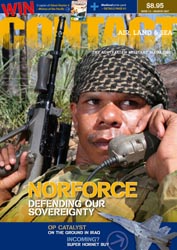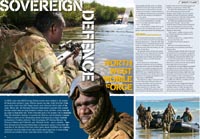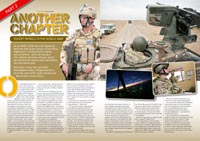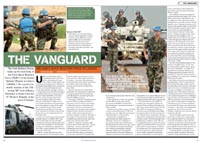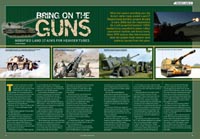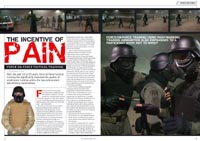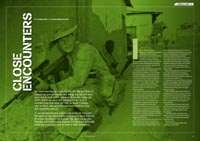|
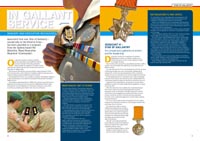
Australia's
first ever Star of Gallantry - second only to the Victoria Cross
- has been awarded to a sergeant from the Sydney-based 4th Battalion,
Royal Australian Regiment (Commando).
Words
Brian Hartigan
Pics ADF
In
issue #13 we covered this and several other awards, but did not
have the space for all. So, here (right) are the abridged extra
citations promised in the hard-copy magazine...
|
Sergeant
A - Star of Gallantry
For conspicuous gallantry in action, and leadership.
During the conduct of an operation in southern Afghanistan in 2006,
a combined coalition force conducted a direct-action mission against
a target in Oruzgan Province.
Upon insertion, the assault force, provided by another Coalition partner,
was surrounded and suffered two wounded and one killed in action.
A commando reaction force was deployed to assist by securing a helicopter
landing zone and covering their withdrawal. As Sergeant A's section
was the lead element of the commando reaction force, he received the
most intense weight of enemy fire.
At the landing zone, the commandos came under immediate heavy fire
from rockets and small arms, from multiple flanks. The commandos held
the position, under fire, for more than an hour.
Sergeant A was responsible for securing the northern flank, repelling
a number of assaults while being engaged from ranges as close as 50m.
After the extraction was complete, the commandos began their return
to base. The enemy anticipated this and had prepared a series of ambushes.
Critically, Sergeant A's vehicle was the first to be engaged at each
ambush location. In each instance, he led his section to assault and
clear opposition from the route, in rapid and aggressive counter attacks,
despite frequent heavy fire.
On one occasion, with absolute disregard for his own safety, Sergeant
A conducted an assault on a machinegun position not more than 30m
to his front.
On at least two other occasions, while being engaged from positions
as close as 5m, and receiving multiple bullet strikes on his vehicle,
Sergeant A was forced to fight his way through ambushes by driving
directly through the killing ground, which he did without hesitation.
Through outstanding leadership and composure under fire, Sergeant
A led the commandos through several ambushes without injury.
Corporal B - Medal for Gallantry
For gallantry and leadership in action.
During an operation, Corporal B's commando platoon was tasked to
carry out the clearance of an anti-coalition militia sanctuary in
the Oruzgan Province, Afghanistan. The platoon was partnered in
support of a Coalition infantry company, which came under heavy
rocket-propelled-grenade and small-arms fire on multiple flanks
resulting in six wounded and one soldier killed in action, effectively
halting their advance.
Through thick vegetation, facing large numbers of dispersed enemy
and under heavy fire, the commando platoon commenced manoeuvring
to provide assistance to the element pinned down. During this move,
the commando platoon received a volley of four rockets that impacted
in the centre of its position, resulting in six Australian soldiers
wounded in action. Corporal B was wounded in the foot.
To regain the initiative, Corporal B's team was tasked to assault
forward and clear a group of compounds from which they were receiving
fire. Under daunting conditions, Corporal B completed a rapid and
aggressive clearance of numerous compounds.
Throughout the afternoon, numerous and relentless probing attacks
by a determined enemy followed. Corporal B displayed extraordinary
leadership and courage, inspiring his team and the remainder of
the platoon to repel the attacks.
He then successfully led a team to infiltrate enemy-held territory,
killing several militia.
Only after the engagement had been completed, Corporal B informed
his Commander of his wound.
Sergeant C - Medal for Gallantry
For gallantry in action in hazardous circumstances.
During the conduct of an operation, a patrol, with Sergeant "C"
as second-in-command, was tasked to establish an observation post
in rugged terrain overlooking an enemy sanctuary. The insertion,
by foot, took 10 hours.
During the course of the next day the patrol coordinated offensive
air support against identified enemy positions.
During the afternoon, the OP became the focus of enemy who made
repeated attempts by day and night to overrun and surround the position.
In one incident the enemy attempted to outflank the post. Sergeant
"C", without regard for his own personal safety, led a
two-man team to locate and successfully kill the enemy.
Other militia later attempted to manoeuvre to attack the patrol
from another flank. Sergeant C, again with little regard for his
personal safety, adopted a fire position that was exposed on high
ground, but which dominated the planned assault. While deliberately
exposing himself to intense rifle and machine gun fire, he neutralised
the lead assault elements and suppressed other attackers until offensive
air support arrived.
Still under sustained fire, Sergeant C then guided indirect fire
to effectively neutralise another enemy advance on his patrol's
position.
His courageous and gallant actions were instrumental in regaining
the initiative and allowed the successful exfiltration of the patrol
on foot before dawn the next day.
Lance Corporal D - Commendation for Gallantry
For gallantry as a patrol medic during the treatment and evacuation
of a wounded Australian soldier.
During an operation, Lance Corporal D's troop entered a pass in
Oruzgan Province in support of a larger coalition force. As they
moved north through the pass they received a large amount of fire
including rocket propelled grenades, small arms and mortars. This
engagement was the first major indication of a large enemy concentration
in the area.
Throughout this engagement, Lance Corporal D provided fire support
with his anti-armour weapon system from the side of a patrol vehicle,
while receiving intense fire from the enemy.
During the engagement, a rocket-propelled grenade exploded immediately
behind Lance Corporal D, seriously wounding his patrol commander.
While still under heavy fire, Lance Corporal D reacted immediately
and lifted his near-unconscious patrol commander into the vehicle.
He manoeuvred the vehicle skilfully out of direct fire, while restraining
the patrol commander who was now unconscious and in danger of falling
out. In dead ground, Lance Corporal D stabilised his patrol commander
and advised troop headquarters of the evacuation requirements.
Throughout the intense battle, Lance Corporal D's composure, application
of skills and knowledge under extreme circumstances were instrumental
in stabilising and extracting the casualty and significantly contributed
to his patrol commander's successful evacuation, despite potentially
life-threatening injuries.
Lance Corporal E - Medal for Gallantry
For gallantry in action in hazardous circumstances.
During an operation, Lance Corporal E was employed as the patrol
scout and sniper in a patrol which was tasked to establish an observation
post near a pass in extremely rugged terrain overlooking an enemy
sanctuary. Early in the patrol, after an arduous ten hour foot insertion,
the patrol was required to coordinate offensive air support to assist
a combined coalition special-forces patrol in contact with the enemy
on the valley floor.
The observation post became the focus of enemy forces and repeated
attempts to locate and surround the position ensued. In one particular
incident, Lance Corporal E was part of a two-man team tasked to
move out of their relatively secure post to locate and neutralise
the militia and regain the initiative. This task was successfully
achieved.
In another incident, militia attempted to attack the observation
post from a different flank. Lance Corporal E again moved neutralise
the threat. Realising that the forward edge of the observation post
was not secure he made a decision to split the team and take up
an exposed position forward of the patrol so he could effectively
employ his sniper rifle. While isolated, he observed a larger group
of militia advancing across open ground. Lance Corporal E effectively
employed his sniper rifle to stop their advance while under accurate
small-arms fire from another group.
Through his efforts, Lance Corporal E maintained the initiative
and ensured that his patrol remained secure by holding this position,
without support, for 20 minutes.
Lance Corporal E's actions, whilst under heavy fire, in a precarious
position, threatened by a numerically superior force, are testament
to his courage, tenacity and sense of duty to his patrol.
Trooper
F - Medal for Gallantry
For gallantry in action in extremely hazardous conditions.
While in an overwatch position of a known enemy stronghold area,
Trooper F's patrol was simultaneously engaged by at least three
groups of anti-coalition militia, within close range, by machinegun
and rocket-propelled grenades. At that time Trooper F, the patrol
machine gunner, immediately returned fire. After firing one short
burst, his vehicle-mounted machinegun malfunctioned and failed to
fire automatic bursts. Despite this, Trooper F remained in the unprotected
turret of his vehicle and attempted to rectify the stoppage. When
he could not be rectified the fault, he dismounted from the vehicle
and, without delay, began to engage enemy positions with anti-armour
weapons and a grenade launcher.
Using all the available weapons systems, moving fire positions,
he aggressively engaged all three anti-coalition militia fighting
positions. At all times he was exposed to, yet disregarded, large
volumes of fire directed at the patrol and himself.
The patrol commander observed the effectiveness of Trooper F's suppressive
fire, which effectively fixed the enemy in location such that they
could then be decisively engaged by other patrol members. The patrol
regained the initiative and successfully countered the attack to
that point.
In the lull, Trooper F returned to his vehicle's turret where he
stripped machinegun and attempted to rectify the problem, without
success.
Shortly after, the enemy attacked again. Under heavy fire, Trooper
F remained in the turret of the vehicle and returned fire as best
as possible with the machinegun, this time with single shots, re-cocking
the weapon after each. He fired 150 rounds in this manner before
the gun began to function correctly.
Trooper F's clear disregard for his own safety while under fire
in extremely hazardous circumstances, displayed significant personal
gallantry in action.
|
